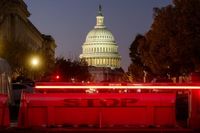The United States federal government has entered uncharted territory as its latest shutdown, which began on October 1, 2025, has now become the longest funding lapse in American history. As of November 5, 2025, this unprecedented shutdown has left about 1.4 million federal employees—either excepted or furloughed—on the brink of missing a second paycheck, with no clear end in sight. The ripple effects of this protracted crisis are being felt far beyond Washington, D.C., as communities across the country grapple with shuttered services, mounting uncertainty, and the specter of long-term damage to the very machinery of government.
According to recent research from the Partnership for Public Service, about half of Americans are now experiencing the shutdown’s impacts firsthand, most commonly through travel delays and the closure of federal facilities. Max Stier, the president and CEO of the Partnership, warned in a press briefing on November 5 that the harm inflicted by this shutdown will not be short-lived. “Our future capacity is going to be diminished substantially,” he told reporters, emphasizing that the effects will be felt across the board, from air traffic controllers to VA doctors and food inspectors. “So many of the functions of our government are highly skilled professionals that require long-term investment.”
As the shutdown drags on, the conversation in policy circles is shifting from immediate relief to the need for systemic reforms. The National Academy of Public Administration (NAPA), a congressionally chartered nonprofit focused on government management, urged Congress on November 5 to modernize the country’s outdated budget process. “Good government depends on strong leadership that can effectively manage the federal budget,” said James-Christian Blockwood, NAPA’s president and CEO. He called for legislative changes such as adjusting the timing of the budget cycle and requiring lawmakers to remain in session until appropriations are enacted. “This shutdown represents a failure in our budget process at a time when public trust in government is already unacceptably low,” Blockwood stated, adding, “This cannot and should not continue.”
Efforts to prevent future shutdowns have gained traction in Congress. In September 2025, lawmakers introduced several bills—including the Eliminate Shutdowns Act, the Government Shutdown Prevention Act, and the End Government Shutdowns Act. While each bill proposes a slightly different mechanism, all aim to force Congress into adopting a continuing resolution, rather than allowing a shutdown, if a spending agreement is not reached. Stier endorsed such changes, saying they would “encourage members to actually come together and do their work … and not make those who have no responsibility for [a shutdown] bear the significant price.” He added pointedly, “No other country does it this way—and it’s not a compliment.”
But as the debate over legislative reform unfolds, a more immediate controversy has captured the attention of federal workers: the question of whether furloughed employees will be guaranteed back pay once the shutdown ends. Despite the Government Employee Fair Treatment Act (GEFTA) of 2019—which states that furloughed workers “shall be paid” for the period of a funding lapse—the Trump administration has sent mixed signals in recent communications.
On November 5, notifications from the administration suggested that only those employees who continued working during the shutdown (so-called excepted employees) would be paid retroactively, casting doubt on whether furloughed workers would receive the same treatment. NASA employees, for instance, received new 30-day furlough notices with language shifting from "will be receiving retroactive pay" to "if you receive retroactive pay," according to reporting from nasawatch.com. The difference between "will" and "if" has not gone unnoticed by anxious staffers, who see the change as a sign of growing uncertainty about their financial future.
This ambiguity was echoed in messages sent from several government agencies. As reported by Truthout, recent communications assured excepted employees that they would receive payment once a funding bill is passed, but omitted any similar guarantees for furloughed staff. Earlier messages, sent in October, had stated more broadly that all employees would be paid for the period of the shutdown, but the latest updates have narrowed that assurance. At least 670,000 federal workers have been furloughed since the start of the crisis, leaving a significant portion of the workforce in limbo.
The apparent shift in the administration’s stance has drawn sharp criticism from lawmakers and unions alike. Senator Chris Van Hollen (D-Maryland) was unequivocal in his response, stating, “The law is the law. That legislation was signed into law—and there is nothing this administration can do to change that.” The Office of Management and Budget has questioned whether furloughed employees are automatically guaranteed compensation, despite the clear intent of the 2019 law. White House Press Secretary Karoline Leavitt, when pressed on November 4, would not provide a definitive answer, saying only, “This is something we are very much open to discussing with Democrats, as part of the discussions about the continuing resolution to keep the government open. It’s something that Republicans are talking with Democrats about right now.”
Behind the scenes, the battle over back pay is tied to the broader political standoff over funding legislation. A leaked memo from the White House in October argued that furloughed workers might not be paid unless their compensation is specifically included in any continuing resolution passed by Congress. Republican leaders, including Speaker of the House Mike Johnson, have pushed for a version of the continuing resolution that does not include back pay for furloughed employees, putting them at odds with Senate Democrats and many federal employee advocates.
Other proposals for reform have surfaced amid the chaos. Some lawmakers have suggested paying federal employees immediately during shutdowns, rather than waiting for a resolution. However, legislation to that effect failed in the Senate in October due to disagreements over whether to include furloughed employees and whether to prevent reduction-in-force (RIF) actions. There are also calls to withhold pay from members of Congress during shutdowns and require them to remain in session until a funding agreement is reached—ideas that have found bipartisan support in principle, if not yet in practice.
For federal employees, the uncertainty is taking a toll. Max Stier of the Partnership for Public Service described the situation as a “layer cake of trauma, incident after incident that [federal employees are] all experiencing.” He added, “As a result, many talented people have already thrown in the towel, and many more are likely to do so.” Even when the shutdown ends, Stier warned, those returning to work will face high workloads and low morale—a daunting prospect for those who have already endured weeks without pay.
As the shutdown grinds on, the stakes are rising not just for federal workers and their families, but for the functioning of the U.S. government itself. With trust in public institutions already at a low ebb, the outcome of this crisis may shape not only the future of the federal workforce, but the very nature of American governance for years to come.





